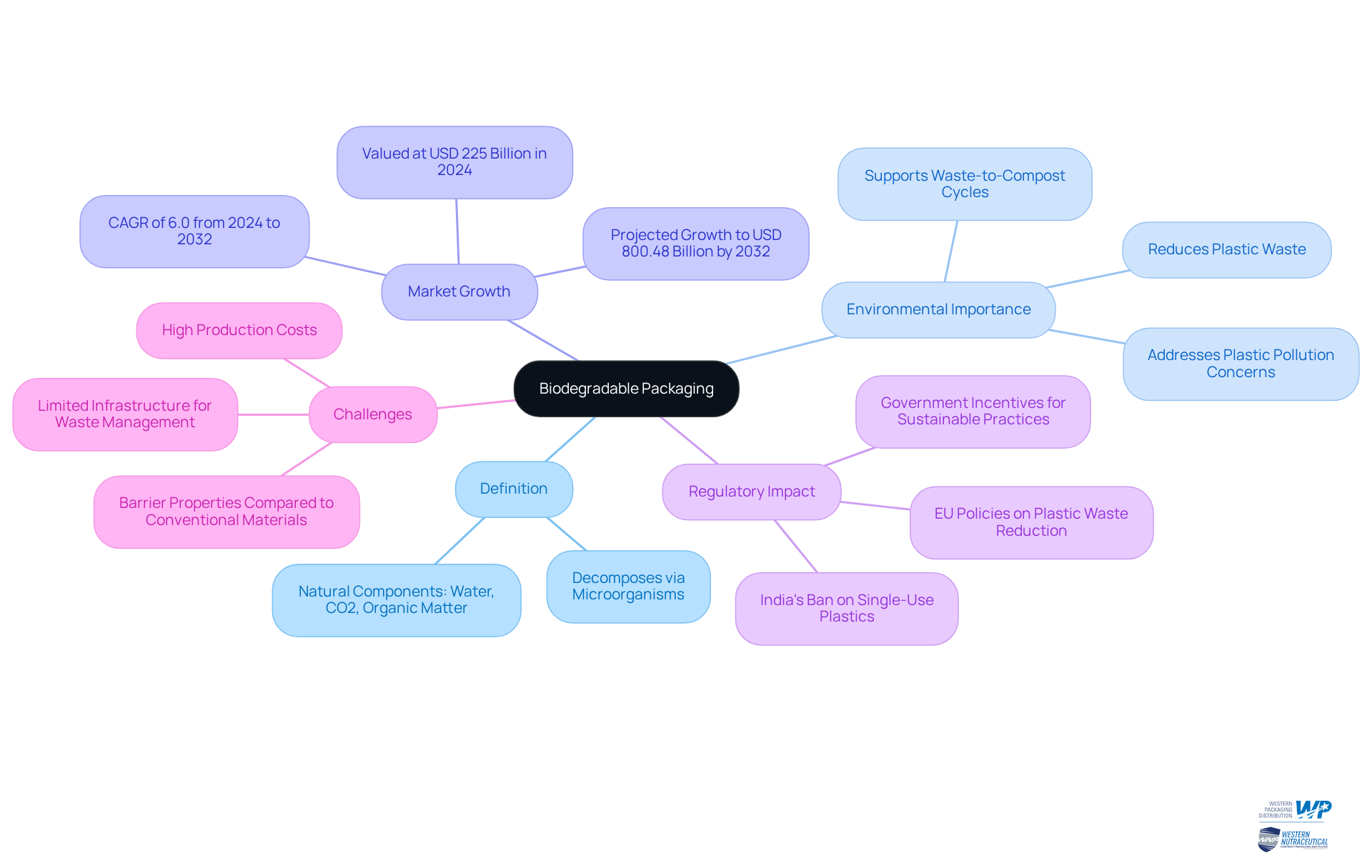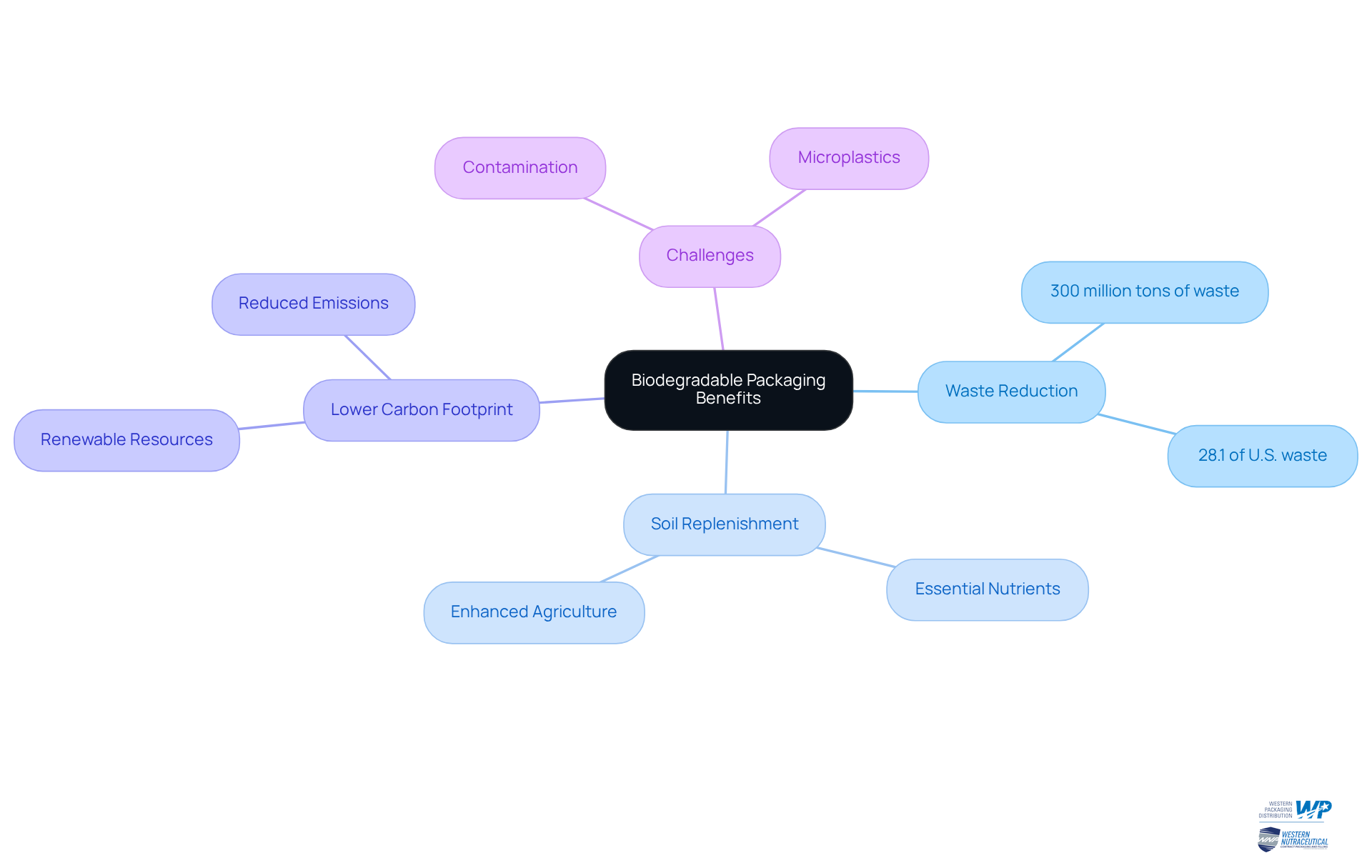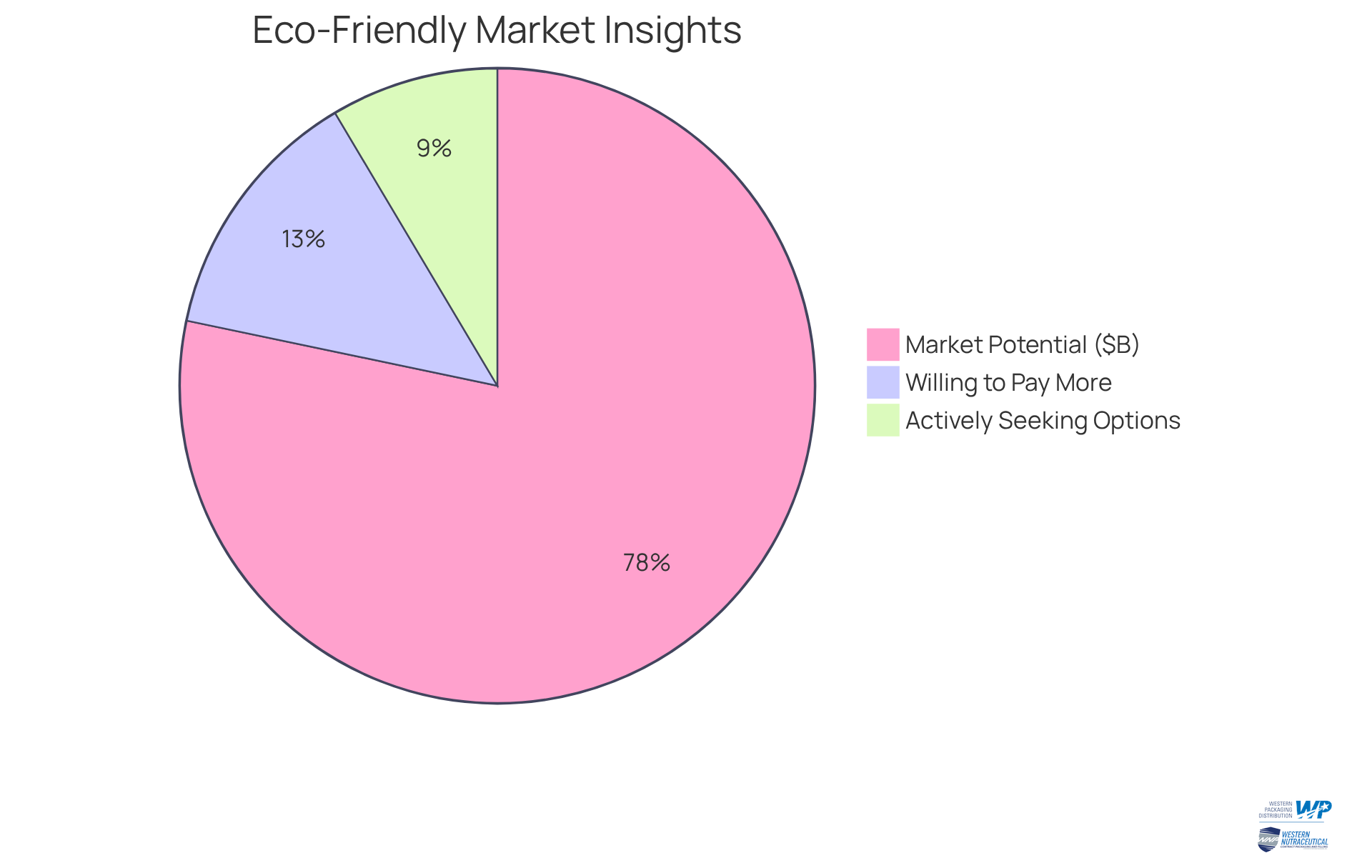Overview
Biodegradable packaging offers significant environmental advantages for manufacturers, notably in reducing landfill waste and meeting the growing consumer demand for sustainable products. By adopting these materials, businesses not only help mitigate plastic pollution but also reap economic benefits such as lower long-term waste disposal costs and an enhanced brand image.
While challenges like higher production costs and performance limitations exist, the overall advantages position companies favorably in a competitive market. Embracing biodegradable solutions is not merely a trend; it is a strategic move towards sustainability that aligns with both consumer expectations and environmental responsibility.
Introduction
The escalating urgency to combat plastic pollution has catalyzed a pivotal shift towards sustainable packaging solutions, with biodegradable materials emerging as a central force in this transformation. Manufacturers are poised to reap not only environmental benefits but also a competitive advantage in a marketplace increasingly shaped by consumer demand for eco-friendly practices.
Nevertheless, the journey toward adopting biodegradable packaging is fraught with challenges, prompting critical inquiries regarding:
- Cost
- Performance
- Regulatory compliance
How can manufacturers effectively navigate this intricate landscape while maximizing the benefits of biodegradable options?
Define Biodegradable Packaging and Its Importance
Biodegradable materials are substances designed to decompose naturally through the action of microorganisms, including bacteria and fungi. Unlike conventional materials that can persist in the environment for centuries, compostable wrappers break down into natural components such as water, carbon dioxide, and organic matter within a relatively short timeframe. This characteristic is vital for reducing waste and minimizing environmental impact. The importance of eco-friendly materials, particularly the benefits of biodegradable packaging, lies in their capacity to address the growing concerns surrounding plastic pollution, making them a crucial aspect of sustainable manufacturing practices. As consumers increasingly seek eco-friendly options, manufacturers recognize the necessity of adopting environmentally friendly materials to bolster their brand image and comply with regulatory mandates.
The global eco-friendly wrapping market was valued at approximately USD 225 billion in 2024 and is projected to grow to around USD 364.76 billion by 2034, with a significant increase expected to reach about USD 800.48 billion by 2032. This substantial growth reflects a shift towards sustainable solutions driven by consumer preferences and regulatory pressures. For instance, India's nationwide ban on certain single-use materials, effective July 1, 2022, has ignited innovation in compostable alternatives, underscoring the urgent need for producers to adapt to these changes.
As sustainability experts emphasize, embracing eco-friendly materials not only reduces plastic waste—estimated at 19-23 million tons entering aquatic ecosystems annually, according to the UN Environment Programme—but also aligns businesses with consumer values, fostering a more responsible and environmentally conscious marketplace. However, it is essential to recognize that compostable materials may not always match the barrier properties of conventional containers, presenting challenges that producers must address. Overall, the integration of biodegradable materials offers significant benefits of biodegradable packaging for manufacturers aiming to make a positive contribution to environmental sustainability.

Explore Environmental Benefits of Biodegradable Packaging
The benefits of biodegradable packaging include significant environmental advantages, primarily achieved by substantially reducing the volume of waste directed to landfills. Annually, approximately 300 million tons of synthetic waste are generated globally, with containers and wrappers accounting for 82.2 million tons, or 28.1%, of total municipal solid waste in the United States.
Unlike conventional plastics, which can persist for centuries, compostable materials decompose naturally, alleviating pressure on waste management systems. For instance, when processed in composting facilities, the benefits of biodegradable packaging include not only its decomposition but also its ability to replenish the soil with essential nutrients, thereby enhancing agricultural practices.
Moreover, these materials typically have a lower carbon footprint, as they are often derived from renewable resources. This transition contributes to a reduction in greenhouse gas emissions and fosters a circular economy, facilitating the efficient reuse and recycling of resources.
However, it is crucial to acknowledge that improper disposal of organic waste can result in soil and water contamination. Furthermore, while compostable containers help mitigate the risk of microplastic pollution, some compostable materials may release microplastics during decomposition, posing a considerable threat to marine ecosystems and biodiversity.
By adopting eco-friendly solutions, manufacturers can significantly contribute to sustainability efforts, including the benefits of biodegradable packaging and environmental protection.

Analyze Economic Advantages for Businesses Using Biodegradable Packaging
Utilizing eco-friendly materials presents substantial financial advantages for companies. While the initial investment in environmentally friendly materials may surpass that of conventional plastics, the potential for long-term savings is considerable. Companies can significantly reduce waste disposal costs through the benefits of biodegradable packaging, as biodegradable materials decompose more efficiently, leading to lower landfill fees. This transition not only curtails expenses but also bolsters brand image, appealing to eco-conscious consumers who are increasingly inclined to pay a premium for sustainable products.
Research indicates that:
- 74% of consumers are prepared to spend more for eco-friendly materials, fostering customer loyalty and creating new market opportunities.
- 48% of consumers in the US actively seek eco-friendly materials when shopping, underscoring the growing market demand.
As global regulations on plastic usage tighten, businesses that adopt biodegradable materials can proactively comply with requirements, avoiding fines and reaping the benefits of biodegradable packaging to secure a competitive edge.
Case studies demonstrate that companies transitioning to sustainable packaging have reported significant cost reductions over time, reinforcing the idea that eco-friendly practices can enhance financial viability. For instance, companies that embrace sustainable methods often discover long-term savings by minimizing waste and reducing shipping expenses.
By integrating eco-friendly substances into their operations, companies not only contribute to environmental sustainability but also position themselves advantageously in a market projected to reach $440 billion by 2025, which increasingly values responsible practices.

Examine Challenges and Considerations in Biodegradable Packaging
While the benefits of biodegradable packaging offer a wealth of advantages, they also introduce challenges that manufacturers must meticulously assess. A primary concern is the heightened production costs associated with environmentally friendly materials, which can be 20% to 30% higher than traditional polymers. Notably, bioplastics are currently three to four times more expensive to produce than conventional materials, which typically range from $0.60 to $0.87 per pound, while compostable alternatives such as PHA can cost between $2.25 and $2.75 per pound. This significant price gap may deter businesses from adopting eco-friendly options.
Moreover, the performance of sustainable materials does not always match that of standard plastics, particularly regarding durability and barrier properties, which are crucial for extending product shelf life. In 2022, only about 9% of containers were compostable, indicating that many producers still rely on traditional materials due to these performance limitations. The eco-friendly container market was valued at USD 238.6 million in 2025 and is projected to grow substantially, reaching USD 460.4 million by 2035, reflecting an increasing consumer demand for sustainable alternatives.
The lack of standardized definitions and regulations surrounding compostable materials further complicates the situation. This ambiguity can result in confusion and mislabeling, hindering consumers' ability to make informed decisions. For example, the UK government is implementing strategies aimed at reducing material waste, encouraging companies to adopt eco-friendly containers; however, differing interpretations of what constitutes 'eco-friendly' can impede progress. Additionally, the UK Plastic Packaging Tax imposes fees on containers containing less than 30% recycled plastic, influencing manufacturers' choices.
To adeptly navigate these challenges, businesses should conduct comprehensive research and collaborate closely with suppliers to identify high-quality eco-friendly materials tailored to their specific needs. Education and transparency regarding the benefits of biodegradable packaging and its limitations are essential for managing consumer expectations and fostering trust. As the market for biodegradable packaging evolves, grasping these challenges will be vital for manufacturers seeking to implement sustainable practices.

Conclusion
Biodegradable packaging signifies a transformative shift in manufacturing practices, underscoring the urgent need for sustainable solutions in an era increasingly defined by environmental consciousness. By adopting biodegradable materials, manufacturers not only contribute to waste reduction but also align their operations with the growing consumer demand for eco-friendly products. This shift is essential for fostering a responsible marketplace that prioritizes sustainability and mitigates the detrimental impacts of plastic pollution.
Key insights throughout this discussion reveal the multifaceted advantages of biodegradable packaging:
- It significantly alleviates landfill waste.
- Enhances soil health through composting.
- Offers economic benefits through potential long-term savings and increased consumer loyalty.
However, challenges such as higher production costs and performance limitations must be navigated carefully. The evolving regulatory landscape further complicates the transition, necessitating thorough research and collaboration among manufacturers, suppliers, and consumers.
Ultimately, the journey towards biodegradable packaging is not merely a trend but a vital step towards a more sustainable future. Manufacturers are encouraged to embrace this opportunity, not only for the environmental benefits but also for the economic advantages that accompany responsible practices. By committing to biodegradable solutions, businesses can lead the way in creating a more sustainable economy, ultimately benefiting both the planet and their bottom line.
Frequently Asked Questions
What is biodegradable packaging?
Biodegradable packaging refers to materials designed to decompose naturally through the action of microorganisms, such as bacteria and fungi, breaking down into natural components like water, carbon dioxide, and organic matter within a relatively short timeframe.
Why is biodegradable packaging important?
It is important because it helps reduce waste and minimizes environmental impact, addressing concerns surrounding plastic pollution and supporting sustainable manufacturing practices.
How is the market for eco-friendly wrapping projected to grow?
The global eco-friendly wrapping market was valued at approximately USD 225 billion in 2024 and is projected to grow to around USD 364.76 billion by 2034, with an expected increase to about USD 800.48 billion by 2032.
What factors are driving the growth of biodegradable packaging?
The growth is driven by consumer preferences for eco-friendly options and regulatory pressures, such as India's nationwide ban on certain single-use materials effective July 1, 2022, which has spurred innovation in compostable alternatives.
What environmental issues are associated with plastic waste?
An estimated 19-23 million tons of plastic waste enter aquatic ecosystems annually, contributing to significant environmental harm.
What challenges do producers face with compostable materials?
Compostable materials may not always match the barrier properties of conventional containers, presenting challenges that producers must address in their production processes.
How do biodegradable materials align with consumer values?
Embracing eco-friendly materials aligns businesses with consumer values, fostering a more responsible and environmentally conscious marketplace.




